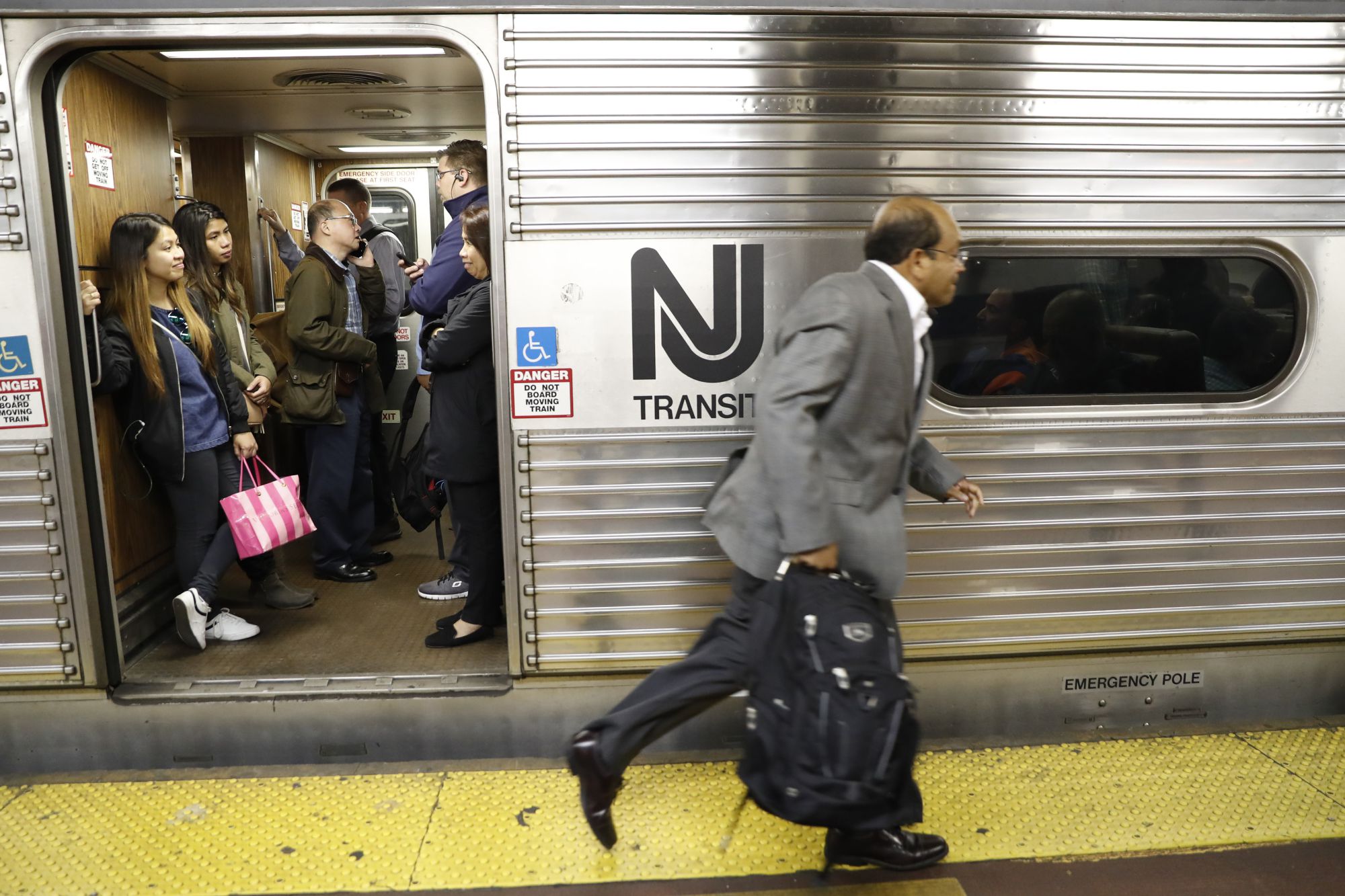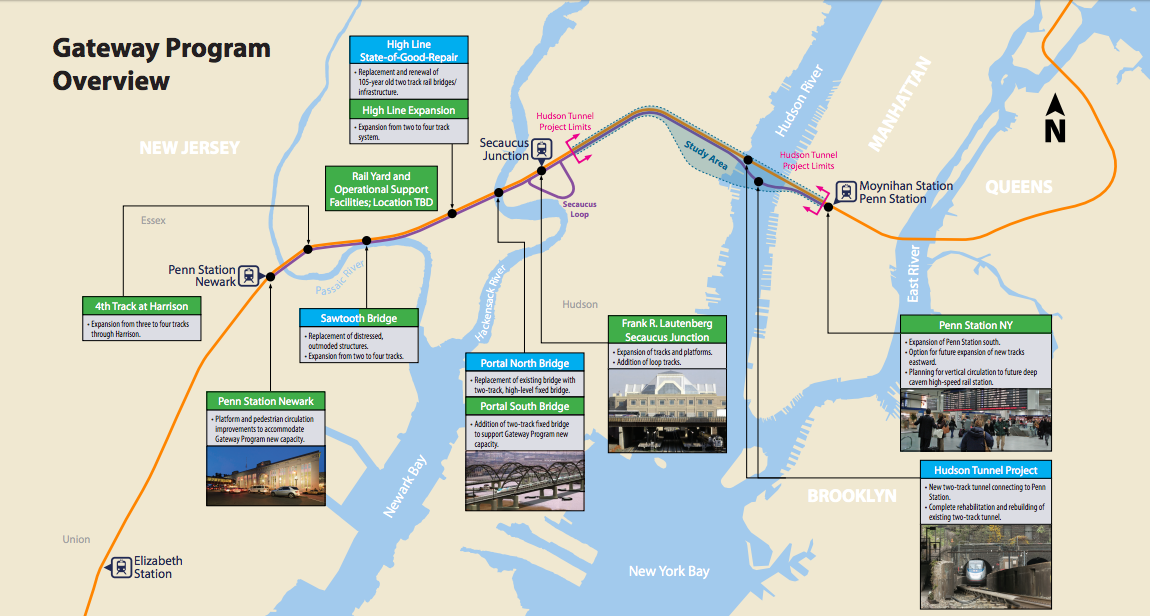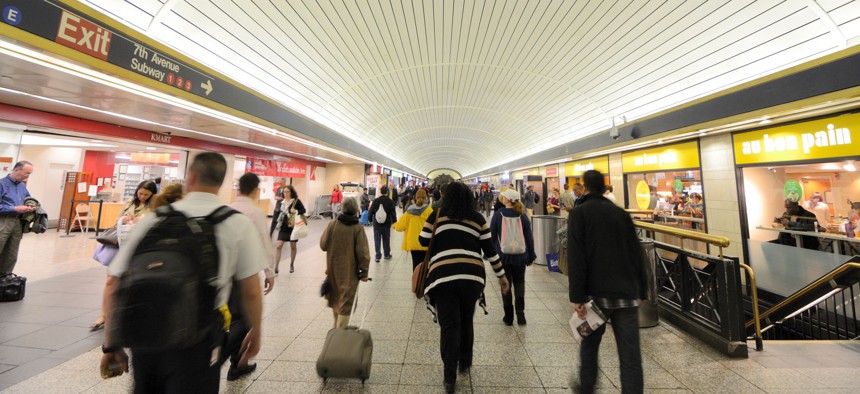Connecting state and local government leaders
Federal and state authorities are making progress in cutting through the regulatory thicket.
An all-star cast of political officials turned out on Oct. 14 in New York City to mark what might seem a minor turn of the bureaucratic gears: the listing of Amtrak’s big trans-Hudson tunneling project on the federal infrastructure dashboard.
To be sure, there were other milestones to be marked, such as the qualifying of two major components of the projects for federal grants and loans, and completion of concrete casing in an expanded subterranean right-of-way that will bring Amtrak and New Jersey Transit trains into Penn Station in midtown Manhattan, North America’s busiest passenger rail hub.
But the proximate cause of the press event at Penn Station was the dashboard announcement—which carried with it the promise of speedier completion of Environmental Impact Statement and other requirements, and thus commencement of construction in early 2019.
The tunnels are the central piece of Amtrak’s Gateway program to ensure reliability of intercity passenger rail traffic along the Northeast Corridor. The two current tunnels, opened 106 years old by the Pennsylvania Railroad, have shown alarming signs of degradation, especially since Hurricane Sandy, which flooded them in 2012. Since then, rail service in and out of Penn Station has been subject to crippling delays, frustrating commuters, especially those in New Jersey who have limited options for getting in and out of Manhattan.

Maintenance crews fight a daily battle to keep the tunnels open.
In 2014, Amtrak’s then-chairman, Joseph Boardman, told regional leaders that the tunnels may have “less than 20 years before we have to shut one or two down” for extensive rehabilitation. That’d mean severely reduced capacity in and out of Penn Station, something authorities have warned would bring economic disaster affecting commerce in states along the Northeast Corridor.
They are a chokepoint for passenger rail traffic between Boston and Washington, D.C., the busiest corridor in the nation, plus serve many thousands of New Jersey Transit commuters who use the system to reach their jobs in New York City.
For three days in July 2015, problems in the tunnels caused major commuting delays for Amtrak and New Jersey Transit passengers. In reaction, U.S. Transportation Secretary Anthony Foxx called the lack of action to repair the shoddy tunnels “almost criminal.”
The Gateway project is not the first attempt to resolve the tunnels crisis.
Years ago authorities approved a plan to build two new tunnels that would have greatly alleviated the commuting problems. They would have opened in 2018. But New Jersey Gov. Chris Christie at the last moment torpedoed the plan in 2010, choosing to spend federal transit dollars instead on road projects in his state.
Speeding Up the New Plan
The cost of the Gateway project far exceeds those of the project Christie quashed. The larger scale of the project and the passage of time have conspired to inflate its costs to nearly $24 billion, according to an Foxx’s estimate. One year ago, the federal government agreed to pay half of the cost, though the sources of the money aren’t nailed down. New York and New Jersey have yet to agree neither on their shares nor on the sources of financing they will need. Amtrak has estimated that the project could be finished in 2030. When the new tunnels are completed, and the old ones refurbished, rail capacity will double beneath the Hudson.
Gateway is unique in its size and scope. At an Oct. 14 press conference in New York City, U.S. Sen. Chuck Schumer, who is in line to replace Harry Reid, as the Senate’s top Democrat, called it “the most important federal transportation project."
At the same event, Foxx said “there is no project in America that is as much a referendum on our present day capacity to do what's right for the American people.”

Notable to infrastructure proponents around the country was the Oct. 14 event’s focus on permitting issues. For if a project of this size can substantially speed up clearance of layers of regulatory hurdles, those in other metro areas can certainly hope for the same.
Permitting for Gateway’s predecessor, the Access to the Region’s Core project cancelled by Christie in 2010, took seven years. Now, the hope is to complete Gateway’s permitting process in two-to-three years.
That’s viewed as a significant advance even by the most ardent of critics of permitting delays, Philip K. Howard, who has created a non-profit institute, Common Good, and written books, reports, articles, letters to editors and speeches decrying the legal/regulatory thicket that slows down so many infrastructure projects in the United States.
In May, at a conference hosted by his law firm, Covington, in Washington, D.C., Howard unveiled a new report titled “Billions for Red Tape: Focusing on the Approval Process for the Gateway Rail Tunnel Project.” In the report, Howard made admittedly “approximate” estimates of the cost of a three-year permitting process—as compared to an 18-month process the report deemed possible.
The 18-month delay, Howard estimated, would increase taxpayer cost by more than $3 billion and he added that a further two-year delay would boost costs by nearly $10 billion.
In an interview, Howard took note of Schumer’s Oct. 14 assertion that with addition of the trans-Hudson tunnels to the federal permitting dashboard, the process could conclude in early 2019. So taxpayers would incur the $3 billion in added costs, he said, since permitting was already under way when the dashboard announcement was made. Still, as an advance over past practices, Howard said he views the dashboard speed-up as a net plus.
Focusing on Permitting
Howard’s persistent and media-savvy criticism has turned up the volume on a movement that’s been underway for half a dozen years or more to build support for regulatory simplification.
An early push came from the U.S. Chamber of Commerce, which in March 2011 published a carefully researched study about delay of energy projects around the country. Chamber executive Bill Kovacs, who wrote the introduction to the report, explained in an interview that energy projects has been chosen for study because of the relatively full public record that’s available on most from state public utility commissions. The report asserted that successful construction of the 351 projects studied “could produce a $1.1 trillion short-term boost to the economy and create 1.9 million jobs.
The Chamber study identified a crucial consequence of regulatory delay: the risk that the private financing committed to the projects can be terminated and diverted elsewhere as investors lose patience.
Kovacs, in his introduction, also took note of rapid permitting that was then taking place under an amendment to the American Recovery and Reinvestment Act of 2009, one of whose programs was to finance construction of “shovel-ready” projects.
Kovacs wrote:
Very few projects are truly ‘shovel ready,’ and getting through the permitting process is difficult if not impossible. At least in the case of Recovery Act projects, recognizing the problems posed by permitting impediments, Senators Barrasso and Boxer amended the Act to require the National Environmental Policy Act (NEPA) process be implemented “on an expeditious basis” and that “the shortest existing applicable process” under NEPA must be used. This amendment made all the difference in getting Recovery Act projects underway: 179,000 of the 250,000 projects covered by the bill received the most expeditious form of compliance treatment possible with regard to NEPA—a categorical exemption—and work was able to begin and jobs were created. Moreover, only 820 projects were subjected to an environmental impact statement, the longest available process under NEPA.
About six months after the Chamber published its report, Jeffrey Zients, at the time deputy director of the Office of Management and Budget unveiled the Federal Infrastructure Projects Dashboard. Zients described it as a “new web page where you can track the federal permitting and environmental review process for expedited high priority infrastructure projects . . . where the significant steps remaining before construction are within the control and jurisdiction of the federal government and can be completed within 18 months.”
The initiative announced by Zients was backed up by Presidential Executive Order 13604 on Improving the Performance of Federal Permitting and Review of Infrastructure Projects, promulgated by President Obama in May 2012.
Kovacs said permits in the early years of the dashboard were often for relatively small “green” energy projects that could contribute to the Administration’s climate agenda. Today most of the project listed under the first tab of the dashboard are energy projects, about a fifth of them dealing with renewable energy.
With and without the dashboard, agencies have been working to improve.
For example, transforming the U.S. Army Corps of Engineers civil works project planning process is expected to reduce the average timeline for projects such as the Central Everglades Planning Project from 10 years to three years or less. Concurrent reviews on projects such as the Southwest Light Rail Transit project in Minneapolis and the Central Valley segment of the California High Speed Rail are expected to reduce project timelines by up to 30 percent, officials say.
Federal agencies have expedited environmental review and permitting of more than 50 major infrastructure projects using the Federal Permitting Dashboard since the 2012 executive order. They include ports and waterways, large-scale renewable energy developments, oil and gas pipelines, railways, roadways, transit, aviation and ecosystem restoration.
Transportation in the Lead
The U.S. Department of Transportation emerged as an early leader in speeding up permitting of the road, transit and other projects in its purview. The federal dashboard now has its own DOT tab, listing about 100 highway, rail, bridge, airport and public transit projects. The addition of the trans-Hudson tunnels project marks the first time that DOT permitting-acceleration processes will be applied to a passenger/freight rail project. Application of the processes to Federal Railroad Administration projects was newly authorized in last year’s landmark Fixing America’s Surface Transportation Act, also known as the FAST Act.
DOT spokesman Clark Pettig responded to an e-mail inquiry by writing:
The Dashboard has not only accelerated time for completing the permitting process, but it has improved collaboration between government agencies and increased transparency, so the public and others can keep track of what is happening with major infrastructure projects. In the case of the Tappan Zee Bridge [over the Hudson River in New York state], the environmental review and permitting was completed in just 1.5 years rather than the usual 3 to 5 year process.
Assistant Secretary for Budget and Programs Shoshana Lew elaborated on the Transportation Department’s substantial history of seeking permitting improvements. In a Nov. 2 interview, she said that since 2011 the department has sought to “turn best practices into common practices” in expediting reviews.
Action has centered in the Federal Highway Administration, which has worked with all 50 states to create “programmatic” agreements specifying statewide or metro-area approaches to approving federally subsidized highway work. These agreements, more than 500 in all, have acted as templates to speed individual projects. The department is “very proud,” of the initiative, Lew said.
The FHWA has developed a website called Every Day Counts, “An Innovation Partnership with States,” that spreads word of permitting innovation, technological advances in highway and bridge construction and more. Its most recent annual report, for example, includes a chapter on improving environmental documentation.
The department has taken steps to simplify and expedite environmental reviews, Lew explained, creating three categories of projects: Those that require full environmental impact statements, those that can be handled with a simpler “environmental assessment,” and those that qualify for a “categorical exclusion” from rigorous review.
The department also last year completed an update of its “Red Book,” whose subtitle is: “Synchronizing Environmental Reviews for Transportation and Other Infrastructure Projects.” Agencies listed on the cover as synchronizers include the U.S. Army Corps of Engineers, the U.S. Coast Guard, the Environmental Protection Agency, the U.S. Fish and Wildlife Service and the National Oceanic and Atmospheric Agency. The 94-page Red Book’s first paragraph hints at the complexities infrastructure sponsors confront:
Transportation and other infrastructure projects require multiple Federal permits and reviews, including reviews under the National Environmental Policy Act of 1969 (NEPA), to ensure that projects are built in a safe and responsible manner and that adverse impacts to the environment and communities are avoided, minimized, and mitigated. The NEPA review, which includes analysis and appropriate documentation, takes into account the potential impacts of the proposed action and investigates reasonable alternatives. It also provides a framework for meeting other environmental review requirements, such as those under the Endangered Species Act of 1973 (ESA), the National Historic Preservation Act of 1966 (NHPA), the Clean Water Act (CWA), the General Bridge Act of 1946 (General Bridge Act), the Magnuson-Stevens Fishery Conservation and Management Act (MSA), and the Marine Mammal Protection Act of 1972 (MMPA). Federal agencies involved in the review of transportation and other infrastructure projects, as well as the agencies proposing these projects, recognize the importance of early and continued coordination in facilitating an effective and efficient review process. However, effective coordination among the diverse sets of participants in these reviews, each with statutorily defined responsibilities, can be challenging due to a multitude of issues such as available time and resources, differing agency missions, and basic policy differences.
FAST-41 and New Council
The Transportation Department’s permitting advances served as a model for Congress as members were working on the regulatory relief section of the FAST Act.
In the House, the chief sponsor of these provisions was U.S. Rep. Tom Marino of Pennsylvania, chairman of the Judiciary subcommittee on regulatory reform, commercial and antitrust law. In the Senate, the lead was taken by Sens. Rob Portman of Ohio and Claire McCaskill of Missouri.
Their efforts produced Title 41 of the FAST Act, to improve permitting. Known as FAST-41, the provisions notably establish a new entity, the Federal Permitting Improvement Council, to oversee the cross-agency federal permitting and review process. It is composed of agency deputy secretary-level members and is chaired by an executive director appointed by the president. “Covered projects,” including the original 34, which were accorded that status, are eligible for expedited review under the law.
The permitting dashboard website’s well-crafted short history of recent years’ permitting improvement efforts notes that FAST-41 codifies “many advances” made by through the executive authority of the Obama Administration. Kovacs, of the Chamber, is complimentary of OMB and other administration officials who have worked to create ways to streamline permitting processes.
With the FAST Act on the books for less than a year, key provisions are just beginning to be implemented. The new council has recently been constituted, and in August, its first executive director, Richard Kidd, assumed his post. Kidd, who is a senior executive at the General Services Administration, had no authority to spend money until the beginning of the new fiscal year on Oct. 1, and he has yet to convene the council.
But Kidd has a detailed working plan for implementing FAST-41, and ambitions to develop templates down the road that could help states, as well as federal agencies, speed up permitting processes. He said in an interview that he intends to have the council and other FAST-41 innovations in place by the end of the year, in expectation that the next President will want to focus early on infrastructure investment.
A key feature of the dashboard is the transparency it provides about agencies involved in a project, required reviews, timelines and more. Kovacs, of the Chamber, cited transparency as a principal benefit for the private sector investors and other businesses the Chamber represents.
Accountability is equally important, said Kidd: “With a coordinated project plan, are agencies holding to deadlines they agreed to?”
The intent of Congress, he said, is to make projects predictable, especially as to timelines, so that financial backers can know what to expect. But, he added, attaining covered status does not guarantee that a project will be approved or that environment or community outcomes are not important.
Kidd is assembling a small staff: about five civil servants and about the same number of consultants/contractors. In the future, he hopes to place a few council staff in federal regional offices, closer to the projects being permitted. That could also help another of the law’s goals: to encourage federal agencies to work closely with state counterparts, and to use state findings on science and other issues where possible or arrange concurrent studies.
The legislation creates a new position in federal agencies: that of chief permitting officer.
It specifies 10 types of infrastructure, and designates a lead agency for each type: for example, the Federal Energy Regulatory Commission for transmission lines, and the Agriculture Department for rural electrification.
It specifies certain key advantages for “covered projects.” Importantly, it cuts the statute of limitations for lawsuits against final permits to two years, from six years. And it stipulates that only those who filed formal comments during the permitting process will be eligible to sue.
In the future, sponsors who want their projects “covered” will be assessed a fee. Revenues will go to support the council’s staff and may render possible Kidd’s ambition of a nationwide system of permitting innovation that could help jumpstart important infrastructure initiatives.
That would be important to many states and localities which have become accustomed to waiting for years on end as complex projects wind their way through government’s labyrinth of regulatory and legal processes.
Timothy B. Clark is Editor at Large at Government Executive’s Route Fifty.

NEXT STORY: A Lesson in Urban Design: Educate Your Residents Before the Ribbon Cutting




